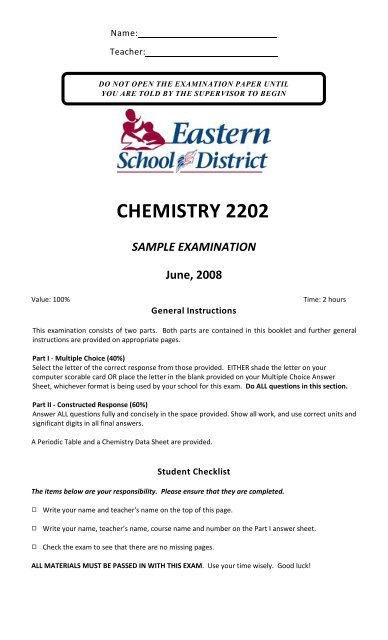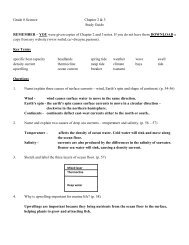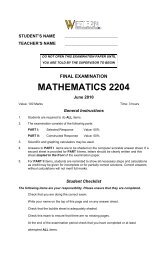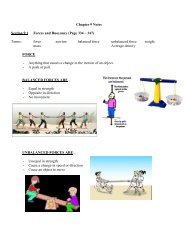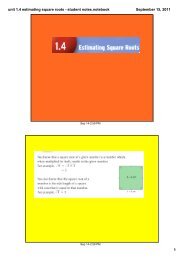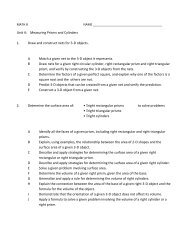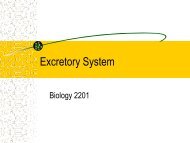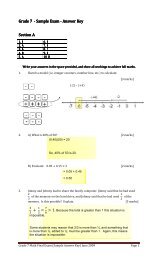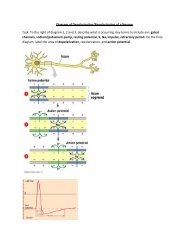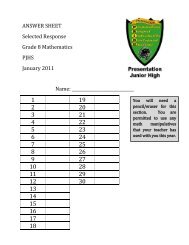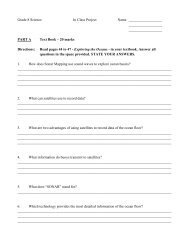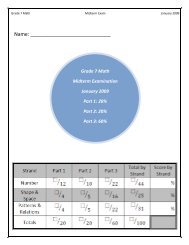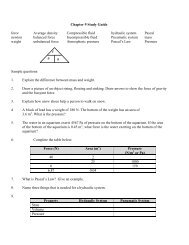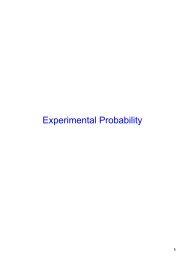Chemistry 2202 Sample Exam 2008 2.pdf
Chemistry 2202 Sample Exam 2008 2.pdf
Chemistry 2202 Sample Exam 2008 2.pdf
- No tags were found...
You also want an ePaper? Increase the reach of your titles
YUMPU automatically turns print PDFs into web optimized ePapers that Google loves.
Name:Teacher:DO NOT OPEN THE EXAMINATION PAPER UNTILYOU ARE TOLD BY THE SUPERVISOR TO BEGINCHEMISTRY <strong>2202</strong>SAMPLE EXAMINATIONJune, <strong>2008</strong>Value: 100% Time: 2 hoursGeneral InstructionsThis examination consists of two parts. Both parts are contained in this booklet and further generalinstructions are provided on appropriate pages.Part I - Multiple Choice (40%)Select the letter of the correct response from those provided. EITHER shade the letter on yourcomputer scorable card OR place the letter in the blank provided on your Multiple Choice AnswerSheet, whichever format is being used by your school for this exam. Do ALL questions in this section.Part II - Constructed Response (60%)Answer ALL questions fully and concisely in the space provided. Show all work, and use correct units andsignificant digits in all final answers.A Periodic Table and a <strong>Chemistry</strong> Data Sheet are provided.Student ChecklistThe items below are your responsibility. Please ensure that they are completed. Write your name and teacher's name on the top of this page. Write your name, teacher’s name, course name and number on the Part I answer sheet. Check the exam to see that there are no missing pages.ALL MATERIALS MUST BE PASSED IN WITH THIS EXAM. Use your time wisely. Good luck!
Part ITotal Value: 40%241. How many moles of CO 2 are present in 5.83 x 10 CO 2 molecules?(A)(B)(C)(D)0.103 mol0.220 mol9.68 mol426 mol2. Which represents sulfur-34?(A)(B)(C)(D)3. How can the molar mass values for each element in a periodic table be calculated?(A)(B)(C)(D)adding the total mass number of protons and neutrons for an isotopedividing the mass number by the atomic number for all isotopesmultiplying the charge on the element by the isotope mass numbertaking the average mass of all naturally occurring isotopes for the element4. What is the molar mass of ammonium carbonate, (NH 4) 2CO 3?(A)(B)(C)(D)78.06 g/mol82.10 g/mol92.07 g/mol96.11 g/mol5. How many moles of helium are present in a 7.00 L balloon at STP?(A) 0.313(B) 0.571(C) 28.0(D) 1576. How many atoms are in a 25.0 g sample of Cu(SCN) 2(s)? The molar mass of Cu(SCN) 2(s) is179.59 g/mol.(A) 1.20 x 10 22(B) 8.37 x 10 22(C) 2.51 x 10 237. What is the percent composition of potassium in potassium dichromate, K2Cr2O 7(s)? Themolar mass of K Cr O (s) is 294.20 g/mol.(D) 5.86 x 10 23(A) 10.1 %(B) 13.3 %(C) 15.3 %(D) 26.6 %2 2 7<strong>Chemistry</strong> <strong>2202</strong> <strong>Sample</strong> <strong>Exam</strong>ination Page 1 of 14June <strong>2008</strong>
8. A student performs a lab to determine the percent composition of water in a hydrated ioniccompound. The following measurements were obtained:mass of beaker and hydrated ionic compound BEFORE heating ......mass of beaker and contents AFTER heating ...................................What is the mass of the original hydrated ionic compound?2.5435 g1.1215 g(A)(B)(C)(D)1.422 g1.4220 g3.665 g3.6650 g9. What is the mass of 0.750 mol of Zn(NO 3) 2(s)? The molar mass of Zn(NO 3) 2(s) is 189.40 g/mol.(A)(B)(C)(D)-33.96 x 10 g-37.04 x 10 g142 g253 g10. In which type of solution is the maximum amount of solvent dissolved?(A)(B)(C)(D)dilutesaturatedsupersaturatedunsaturated11. Which is an aqueous solution?(A)(B)(C)(D)gasolineoilpure watersalt water12. Which substance, when dissolved in water, is considered to be a non-electrolyte?(A)(B)(C)(D)CH3OHHClNaClNH OH413. Which solution is the most concentrated?(A)(B)(C)(D)150. mL of 2.00 mol/L HCl(aq)200. mL of 0.100 mol/L MgCr2O 7(aq)350. mL of 1.50 mol/L LiNO 3(aq)500. mL of 0.250 mol/L NH HCO (aq)4 314. What is the final concentration when 2.00 L of 0.50 mol/L HCl(aq) is diluted to 10.0 L?(A)(B)(C)(D)0.10 mol/L0.40 mol/L2.5 mol/L10. mol/L15. Which compound has low solubility in water?(A) AgNO 3(B) HClO 4(C) Na2SO4(D) PbCl 2<strong>Chemistry</strong> <strong>2202</strong> <strong>Sample</strong> <strong>Exam</strong>ination Page 2 of 14June <strong>2008</strong>
16. What mass of mercury would be in a 325 g salmon fillet that contains 0.50 ppm (parts permillion) of mercury?(A)(B)(C)(D)-41.63 x 10 g-71.63 x 10 g6.15 x 10 3 g6.15 x 10 g617. In the equation below, how many moles of Cl 2(g) would react with four moles of Na(s)?(A) 1(B) 2(C) 4(D) 82 Na(s) + Cl 2(g) 2 NaCl(s)18. Which is used to determine the purity of gypsum, CaSO 4 2H2O(s), which is madesynthetically from CaCO (s) and SO (g)?3 2(A)(B)(C)(D)Avagradro's Numberpercent compositionpercent yieldStandard Pressure19. Which type of bonding mostly involves the transfer of electrons?(A)(B)(C)(D)covalenthydrogenionicmetallic20. How many bonding electrons are in an atom of nitrogen?(A) 2(B) 3(C) 5(D) 821. Which is the electron dot formula for methanol?(A)(B)(C)(D)<strong>Chemistry</strong> <strong>2202</strong> <strong>Sample</strong> <strong>Exam</strong>ination Page 3 of 14June <strong>2008</strong>
22. Which has a multiple covalent bond?(A) H 2(B) HBr(C) NaCl(D) O 223. Which VSEPR shape corresponds to a molecule with two lone pairs of electrons and twobonded groups of electrons around its central atom?(A)(B)(C)(D)linearpyramidaltetrahedralV-shaped (bent)24. Which atom would have the greatest electronegativity for electrons in a bond?(A)(B)(C)(D)BrCsFNa25. Which molecule contains polar covalent bonds, yet the molecule itself is nonpolar?(A)(B)(C)(D)CH2O (trigonal planar)CO 2 (linear)H2O (V-shaped)NH (pyramidal)326. A chemical has the formula "XCO", where "X" is an unknown nonmetal. What is the identityof X if the compound is polar?(A)(B)(C)(D)FNOS27. Which intermolecular force involves temporary dipoles attracting in neighboring molecules?(A)(B)(C)(D)Dipole-DipoleHydrogen BondingLondon dispersionNetwork Covalent28. Which bond is slightly polar covalent?(A)(B)(C)(D)Br-ClCs-FF-FH-F29. Which substance would be expected to be brittle and conduct electricity when molten, yet notconduct electricity as a pure solid?(A) C12H22O11(B) NaCl(C) (NH 2) 2CO(D) SiO 2<strong>Chemistry</strong> <strong>2202</strong> <strong>Sample</strong> <strong>Exam</strong>ination Page 4 of 14June <strong>2008</strong>
30. Which is an example of a network covalent solid?(A) CH 4(B) MgBr 2(C) NCl 3(D) SiC31. Which force of attraction binds together the nitrogenous bases below?adenine thymine(A)(B)(C)(D)Dipole-DipoleHydrogen BondingLondon dispersionNetwork Covalent32. Which is an organic compound?(A) CH 4(B) CO(C) CO 2(D) CS 233. What is the name of the molecule below?(A) butane(B) pentane(C) propane(D) tetrane34. Which molecule is "p-ethylmethylbenzene"?(A)(B)(C)(D)<strong>Chemistry</strong> <strong>2202</strong> <strong>Sample</strong> <strong>Exam</strong>ination Page 5 of 14June <strong>2008</strong>
35. Which is an ether?(A)(B)(C)(D)36. What type of compound is CH3COOH?(A)(B)(C)(D)aldehydecarboxylic acidketoneester37. What is the IUPAC name of the compound below?(A)(B)(C)(D)methanamidemethanamineethanamineethanamide38. Which compound can react in an addition reaction?(A)(B)(C)(D)<strong>Chemistry</strong> <strong>2202</strong> <strong>Sample</strong> <strong>Exam</strong>ination Page 6 of 14June <strong>2008</strong>
39. Which compound reacts with ethanoic acid to produce a substance which has an odour similarto oranges?(A)(B)(C)(D)40. Which monomer would be used to produce the polymer ?(A)(B)(C)(D)END OF PART I<strong>Chemistry</strong> <strong>2202</strong> <strong>Sample</strong> <strong>Exam</strong>ination Page 7 of 14June <strong>2008</strong>
Part IIConstructed ResponseTotal Value: 60%Answer ALL questions in the space provided. Show all workings and report all final answers withcorrect significant digits and units.Value41. (a) A compound contains 65.45% carbon, 5.49% hydrogen, and 29.06% oxygen by mass.4 (i) Find the empirical formula of the compound.2 (ii) Find the molecular formula of the compound if its molar mass is 110.10 g/mol.<strong>Chemistry</strong> <strong>2202</strong> <strong>Sample</strong> <strong>Exam</strong>ination Page 8 of 14June <strong>2008</strong>
Value41. (continued)3 (b) (i) Calculate the mass of sodium sulfate, Na2SO 4, required to make 250.0 mL ofsolution with a concentration of 0.800 mol/L.2 (ii) Briefly state the steps you would use to make the Na2SO 4(aq) solution (above) inthe lab. You may wish to refer to the lab equipment below in your response. NOTE:Not all of the apparatus would need to be used.(filter paper)(weighingdish)(balance)___________________________________________________________________________________________________________________________________________________________________________________________________________________________________________________________________________________________________________________________________________________________________________________________________________________________________________<strong>Chemistry</strong> <strong>2202</strong> <strong>Sample</strong> <strong>Exam</strong>ination Page 9 of 14June <strong>2008</strong>
Value41. (continued)4 (c) For the reaction below, calculate the mass of Ag2SO 4(s) that is expected if 250.0 mL of0.500 mol/L AgNO (aq) reacts completely with excess Li SO (aq).3 2 4Li2SO 4(aq) + 2 AgNO 3(aq) Ag2SO 4(s) + 2 LiNO 3(aq)7 (d) The beaker below was found with a torn label that reads Na 2S? ("sodium sulf...")where the ending of the compound's name is missing.In order to determine the identity of the unknown compound, the complete reaction belowwas performed using 5.000 g of the unknown compound Na2S? (aq) and 634.7 mL of0.1250 mol/L AgNO (aq).3Na2S? (aq) + 2 AgNO 3 (aq) 2 Ag2S? (s) + 2 NaNO 3(aq)(Note: "S?" is the unknown sulfur-containing anion.)What is the identity of the unknown compound, Na2S? (aq) ? Show workings.<strong>Chemistry</strong> <strong>2202</strong> <strong>Sample</strong> <strong>Exam</strong>ination Page 10 of 14June <strong>2008</strong>
Value41. (continued)(e) When potassium metal is heated in nitrogen, red, explosive K3N(s) powder forms.6K(s) + N 2(g) 2K3N(s)5 If the reaction above is performed using 80.0 g of K(s)and 40.0 L of N 2(g) at STP,determine the theoretical yield of K N(s), in grams.342. (a) For the molecule, PFH 2:6 (i) Draw the electron dot diagram.(ii) Draw the VSEPR shape diagram.(iii) What is the name of the molecular shape?________________________(iv) Is the molecule polar or nonpolar?________________________<strong>Chemistry</strong> <strong>2202</strong> <strong>Sample</strong> <strong>Exam</strong>ination Page 11 of 14June <strong>2008</strong>
Value42. (continued)(b) A molecular compound contains only carbon, hydrogen and oxygen. The compound5 is polar, and contains one multiple bond, one carbon atom, and two oxygen atoms.Draw the electron dot diagram and the VSEPR shape diagram for this compound.electron dot diagramVSEPR shape diagram(c) The VSEPR shapes of three molecules are given below.3 (i) Under each shape, indicate with a yes (Y) or no (N) the type of intermolecularforce present in each molecule.Molecule "A" Molecule "B" Molecule "C"London DispersionDipole-DipoleHydrogen Bonding3 (ii) Explain, using intermolecular forces, which molecule in (i) above has the highestboiling point and which one has the lowest boiling point._____________________________________________________________________________________________________________________________________________________________________________________________________________________________________________________________________________________________________________________________________________________________________________________________________________________________________________________________________________________________________________________________________________________________________<strong>Chemistry</strong> <strong>2202</strong> <strong>Sample</strong> <strong>Exam</strong>ination Page 12 of 14June <strong>2008</strong>
43. (a) Name each compound using IUPAC naming rules.Value6(i) Name: ______________________________________________________________(ii) Name: _____________________________________________________________(iii) Name:_____________________________________________________________4 (b) Draw structural diagrams for the following:(i) ethyl propanoate(ii) 2-chloro-3-hexanone<strong>Chemistry</strong> <strong>2202</strong> <strong>Sample</strong> <strong>Exam</strong>ination Page 13 of 14June <strong>2008</strong>
Value43. (continued)3 (c) For the reaction below:(i) identify the reaction type. _____________________(ii) complete and balance the reaction.(iii) show structures for all organic molecules.3 (d) Complete the two-step reaction process from start to finish by filling in the organicstructures for "Compound A" and "Compound B".Step 1:"Compound A"Step 2:"Compound A" + HOH +"Compound B"END OF PART II<strong>Chemistry</strong> <strong>2202</strong> <strong>Sample</strong> <strong>Exam</strong>ination Page 14 of 14June <strong>2008</strong>


